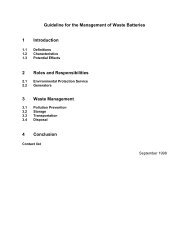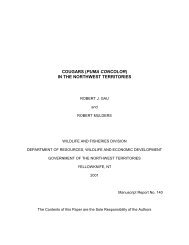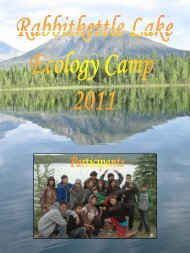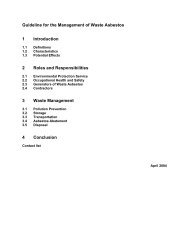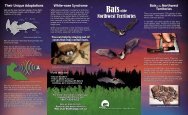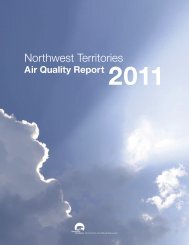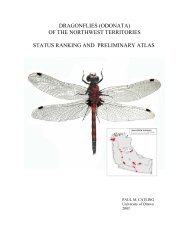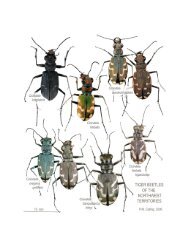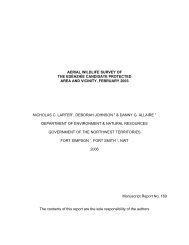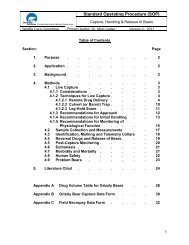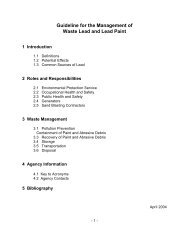Small Mammal Surveys - Environment and Natural Resources ...
Small Mammal Surveys - Environment and Natural Resources ...
Small Mammal Surveys - Environment and Natural Resources ...
You also want an ePaper? Increase the reach of your titles
YUMPU automatically turns print PDFs into web optimized ePapers that Google loves.
<strong>Small</strong> <strong>Mammal</strong> Surveyin the Northwest TerritoriesReport 1998Suzanne CarrièreWildlife <strong>and</strong> FisheriesDepartment of <strong>Resources</strong>, Wildlife <strong>and</strong> Economic DevelopmentGovernment of the Northwest TerritoriesYellowknife NTX1A 3S81999Manuscript Report No. 115THE CONTENTS OF THIS PAPERARE THE SOLE RESPONSIBILITY OF THE AUTHOR
ABSTRACT<strong>Small</strong> mammals play a keystone role in both arctic <strong>and</strong> boreal ecosystems; theyare a major prey species for many northern carnivores. Cyclic fluctuation in theabundance of small mammals is reflected in similar fluctuations in the abundanceof their predators. The NWT <strong>Small</strong> <strong>Mammal</strong> Survey is designed to monitorchanges in voles (Clethrionomys rutilus, C. gapperi, Microtus oeconomus, M.pennsylvanicus, M. xanthognathus, Phenacomys interdius), mice (Peromyscusmaniculatus, Zapus hudsomius), lemmings (Synaptompys borealis, Lemmussibiricus, Dicrostonyx groenl<strong>and</strong>icus), <strong>and</strong> shrews (Sorex sp.) abundance in 15sites across five ecozones in the Northwest Territories <strong>and</strong> Nunavut (April 1999).The survey is done using ΑMuseum Special≅ snap traps placed on two transectsin typical habitat. In addition, two special projects were initiated to (1) collectspecimen of deer mice to be tested for hantavirus <strong>and</strong> (2) re-examine specimensfor species identification. This report adds to the information given in Shank(1996). It includes summaries of all trapping activities up to 1998 <strong>and</strong> providesupdate reports on the two special projects.
TABLE OF CONTENTSABSTRACTLIST OF FIGURESLIST OF TABLESIIIIIIIINTRODUCTION 1METHODS 2Trapping Project 2Hantavirus Project 3Identification Project 4RESULTS AND DISCUSSION 4Site reports for 1998 7Boreal Plains - Fort Smith 7Taiga Shield - Yellowknife 7Taiga Plains - Fort Simpson 8Taiga Plains - Fort Smith 8Taiga Plains - Norman Wells 8Hudson Bay - Arviat 8Hudson Bay - Coral Harbor 9Hudson Bay - Repulse Bay 9Southern Arctic Interior - Baker Lake 9Southern Arctic Interior - Daring Lake 9Southern Arctic Coast - Hope Bay 10Southern Arctic Coast - Kugluktuk 10Melville Sound Isl<strong>and</strong>s - Breakwater, Cockburn, Jameson, Wilmot, Hurd Ills 10High Arctic - Byron Bay 10High Arctic - Walker Bay 10High Arctic - Bylot Isl<strong>and</strong> 11Hantavirus Project 11Identification Project 11LITERATURE CITED 12ii
APPENDIX 1. ANNOTED LIST OF SPECIES CAPTURED AT LEAST ONCESINCE 1990 IN EACH SITE ABOVE THE TREELINE (TABLE 1.A, B) ANDBELOW THE TREELINE (TABLE 1.C). 13APPENDIX 1. CON'T 14APPENDIX 2. SUMMARY OF TRAP-NIGHTS, NUMBER OF EACH SPECIESCAUGHT, MISFIRES, AND ABUNDANCE INDICES FOR EACH STUDY SITEBELOW (A) AND ABOVE THE TREELINE (B). 15APPENDIX 3. LIST OF LOCATIONS, LATITUDE AND LONGITUDE INDEGREES, NAME AND AGENCY OF THE MAIN COOPERATOR FOR EACHYEAR OF THE SMALL MAMMAL SURVEY, NORTHWEST TERRITORIES. 21LIST OF FIGURESFigure 1. Trapping locations for the <strong>Small</strong> <strong>Mammal</strong> Survey in the NorthwestTerritories <strong>and</strong> Nunavut. ................................................................................3Figure 2. Abundance indices (total captured per 100 trap-nights) near sixcommunities below the tree line.....................................................................5Figure 3. Abundance indices (total captured per 100 trap-nights) on 17 locationsnear communities <strong>and</strong> research stations in above the tree line. The surveywas not performed in 1998 on locations marked by an open circle ...............6Figure 4. Abundance index of Red-backed voles (A) <strong>and</strong> Deer mice (B) inwestern Northwest Territories. .......................................................................7LIST OF TABLESTable 1. Specimen collected for hantavirus testing since 1994. .........................11iii
INTRODUCTION<strong>Small</strong> mammals play a keystone role in both arctic <strong>and</strong> boreal ecosystems(Krebs 1996). <strong>Small</strong> mammals are a major prey species for foxes, marten(Martes americana), raptors, <strong>and</strong> other carnivores. Cyclic fluctuation in theabundance of small mammals is reflected in similar fluctuations in the abundanceof their predators (Finerty 1980, Krebs 1996, Boonstra et al. 1998). For example,abundance cycles in small mammal populations have been associated withchanges in marten harvest (Tungilik <strong>and</strong> Shank 1994).The NWT <strong>Small</strong> <strong>Mammal</strong> Survey is designed to monitor changes in vole, mouse,lemming, <strong>and</strong> shrew abundance across five ecozones in the NorthwestTerritories <strong>and</strong> Nunavut (April 1999).Trapping projectMajor objectives are:1- to develop "the capacity to predict small mammal abundance at particularlocations" (Shank 1997),2- to "describe the geographic scale of population synchrony" (Shank 1997), <strong>and</strong>3- to develop a tool for predicting seasons of good harvest potential for somepredators on small mammals, e.g., marten, lynx (Lynx canadensis), <strong>and</strong> arcticfox (Alopex lagopus).Hantavirus projectAn additional objective of the NWT <strong>Small</strong> <strong>Mammal</strong> Survey to collect specimen ofdeer mice (Peromyscus maniculatus) to be tested for hantavirus. The infection istransmissible from mice to human by simple inhalation of dried excrement <strong>and</strong>can cause death. There is yet no evidence that Hantavirus is present in NWTsince testing was initiated in 1994. In 1998 cases were reported as far north asnear Fort McMurray, Alberta (M. Bradley, Biologist, Fort Smith, RWED, pers.comm.).Identification projectA special project within the <strong>Small</strong> <strong>Mammal</strong> Survey was initiated in 1997 <strong>and</strong>continued in 1998. With current identification keys, small mammals arenotoriously difficult to identify to species in the field <strong>and</strong> errors may occur even inthe laboratory. Errors were noted in 1997 in the identification of some specimencollected in 1995, 1996 <strong>and</strong> 1997. Our underst<strong>and</strong>ing of the natural variations insmall mammal abundance <strong>and</strong> of their effects on fur-bearer abundance dependto some extent on a correct species identification.1
Furthermore, the northern distribution of northern red-backed voles(Clethrionomys rutilus) <strong>and</strong> southern red-backed voles (C. gapperi) is stillunknown. There is evidence that their distribution, as reported in mammalogytextbooks <strong>and</strong> field guides, are based on misidentified specimens.The 1998-99 objectives of the identification project were to:- verify the species identification of the 1998 specimens,- build a reference collection <strong>and</strong> report for the identification of small mammalsin the field <strong>and</strong> the laboratory, <strong>and</strong>- determine the spatial distribution of the two species of voles in the NorthwestTerritories.This interim report updates the information given in Shank (1997) by addingsummary capture data for 1997 <strong>and</strong> 1998. Additional information is alsoprovided for 1998: trap line location, trappers' name <strong>and</strong> weather. As in previousyears, government biologists, Renewable <strong>Resources</strong> Officers, casualgovernment employees, academic researchers, <strong>and</strong> environmental consultantsperformed data collection in 1997-98. At some sites, students assisted in datacollection within research camps or school field courses. A successful NWT<strong>Small</strong> <strong>Mammal</strong> Survey is possible because of their efforts.Trapping ProjectMETHODSThe trapping methods are unchanged since 1990. Each cooperator has theflexibility to alter methods to suit local circumstances, but the recommendedprocedures are as follows (Shank 1997):1) Trapping is to be done solely with ΑMuseum Special≅ snap traps.2) Traplines are to be two parallel lines ca. 100 m apart running 250 mthrough typical habitat. Traplines should be as close to the investigators'work stations as possible.3) Traplines are to be marked <strong>and</strong> consistently used from one year to thenext.4) A basic ecological description of the traplines should be made.5) Trapping stations are to be 10 m apart <strong>and</strong> consist of one or two trapsplaced at the best location within 2 m of the station.6) Bait is to consist of a mixture of peanut butter <strong>and</strong> rolled oats.7) Traps should be checked once per day before 10 am. If the line cannot bechecked on a particular day, the traps should be sprung the night before.8) Data sheets should be filled out daily <strong>and</strong> submitted at the end of thetrapping period.2
9) Captured animals are to be identified to species. It is useful, but notnecessary, to collect other data such as weight, sex, <strong>and</strong> reproductivecondition. If convenient, the specimens should be labeled <strong>and</strong> frozen forpossible use in future studies.10) The goal is to achieve 500 trap-nights (TN) each year.11) The trapping period should be consistent between years. August is therecommended month.Data are reported as capture indices, defined by number of trapped specimensper 100 trap-nights. Capture indices during this survey are used as an indicatorof abundance in a specific area, i.e., density. Trap-nights are defined as thenumber of traps set multiplied by the number of nights deployed, minus numberof misfires <strong>and</strong> non-target species. Misfires are traps sprung without a capture.Target species are listed in Appendix 1.Weather during trapping was recorded at each site, as strong wind <strong>and</strong> rain areknown to increase frequency of misfires. Other causes of misfires <strong>and</strong> anysystematic problems when trapping were also recorded.Trapping locations for the <strong>Small</strong> <strong>Mammal</strong>Survey in the Northwest Territories <strong>and</strong>Nunavut.Siksik LakeBylot Isl<strong>and</strong>Pond InletInuvikOne-eye JackByron Bay Walker BayKugluktukHope BayNorman WellsRepulse BayMelville Sound Isl<strong>and</strong>sDaring LakeBaker Lake Coral HarborFort Simpson Lac de GrasYellowknifeRankin InletFort LiardArviatFort SmithSites where an abundance index was measured in 1998 are in black. Dotted line indicatesapproximate location of tree line.Figure 1. Trapping locations for the <strong>Small</strong> <strong>Mammal</strong> Survey in the Northwest Territories <strong>and</strong>Nunavut.Hantavirus ProjectWhenever possible all deer mice trapped in Yellowknife, Fort Smith <strong>and</strong> FortLiard are sent for hantavirus testing. In addition, voles (red-backed <strong>and</strong> chestnutcheekedvoles) <strong>and</strong> lemmings are sent for testing. In 1998, all speciment weresent to:Harvey ArtsobChief, Zoonotic Diseases3
Laboratory Center for Disease ControlFederal Laboratories1015 Arlington StreetWinnipeg, ManitobaR3E 1S1tel.: (204) 789-2134fax: (204) 789-2082e-mail: Harvey_Artsob@hc-sc.gc.caHealth <strong>and</strong> Welfare Canada for testing.Identification ProjectSpecimens for species identification were frozen for transportation <strong>and</strong> sent toYellowknife RWED Laboratory for species identification using externalcharacteristics <strong>and</strong> dental patterns (Banfield 1981). Additional measurementswere obtained to differentiate between southern <strong>and</strong> norhtern red-backed voles:molar eruption, wear, <strong>and</strong> tarnish indices, presence of double molar roots, bodyweight, tail length <strong>and</strong> colour, ear length <strong>and</strong> molt index. Teeth patterns of lower<strong>and</strong> upper jaws were photographed at 50x magnification.The 1998 collection from Norman Wells was sent (Export Permit: 037327) toArianna Zimmer for her 4th year project under the supervision of Dr. WarrenFitch at University of Calgary. She will study the frequency of occurrence ofinternal parasites in small mammals.RESULTS AND DISCUSSIONSummary results from 1990-1998 are provided in Appendix 2. Graphicalrepresentations of capture indices on sites in forested regions (NWT) areprovided in Figure 2, on sites above treeline (mostly in Nunavut in April 1999) inFigure 3. Posters were created to help biologists <strong>and</strong> wildlife officers in theirconsultation with trappers <strong>and</strong> community members throughout NWT. Theposters are reproduced in Appendix 4.Site reports for 1998 (see below) <strong>and</strong> graphs (see Figures 2 <strong>and</strong> 3) were groupedso that sites that are apparently synchronized are shown together. Sites weregrouped as follows: NWT, Taiga Plains, Taiga Shield, <strong>and</strong> Boreal Plains;Nunavut: High Arctic, Melville Sound, Southern Arctic Coast, Southern ArcticInterior, Hudson Bay. No additional analyses to detect synchrony wereperformed beyond those reported in Shank (1997). Analyses of synchronismamong sites for each major species will be possible in later years with continuousverification of species identification.Sites on the Taiga Plains were characterized by peak captures (species grouped)in 1994-95 <strong>and</strong> in 1998, <strong>and</strong> by lows in 1991-92 <strong>and</strong> 1996 (Figure 2). The Boreal4
Plains site (Fort Smith) <strong>and</strong> Taiga Shield site appears not to be synchronized(Figure 3).<strong>Small</strong> mammal abundance indices in theWestern Northwest Territories, 1990-98InuvikAbundance Index (#per 100 trap-nights)6050403020100Taiga Plains sitesFort Liard(Forested)Fort Liard(Logged)FortSimpsonInuvikNorman Wells1990 1992 1994 1996 1998yearNormanWellsFort SimpsonFort LiardYellowknifeTaiga Shield <strong>and</strong> Boreal Plains sitesFort SmithAbundance index (#per 100 trap-nights)6050403020100Fort SmithYellow knife1990 1992 1994 1996 1998yearFigure 2. Abundance indices (total captured per 100 trap-nights) near six communities below thetree line.Captures indices in the High Arctic, Melville Sound (exception of Jameson I.),<strong>and</strong> Southern Arctic Coast peaked in 1996 (Figure 3). Where data exist, there isalso evidence that a peak occurred in 1992-93 in other High Arctic sites (WalkerBay: Figure 3; One-eye Jack; not shown). Captures indices at Hudson Bay sitespeaked in 1994 <strong>and</strong> 1997 (Figure 3). Southern Arctic sites on the continentalinterior (Daring Lake <strong>and</strong> Baker Lake) may have peaked in 1994, but did notpeak in 1996 as other Arctic sites (Figure 3).5
Abundance index (# per 100trap-nights)Abundance Index (# per 100trap-nights)Melville Sound Isl<strong>and</strong>s2018Breakw ater I..16Cockburn I.14Jameson I.12Wilmot I.108Hurd I.64201989 1990 1991 1992 1993 1994 1995 1996 1997 1998 1999yearSouthern Arctic Coastal sites2018Hope Bay161412Kugluktuk10864201990 1991 1992 1993 1994 1995 1996 1997 1998 1999year<strong>Small</strong> mammal abundance indices inNunavut, 1990-98Bylot Isl<strong>and</strong>Pond InletByron BayOne-eye Jack LakeKugluktuk Walker BayHope BayMelville Sound Isl<strong>and</strong>sRepulse BayDaring LakeBaker Lake Coral HarborLac de GrasAbundance Index (# per 100trap-nights)Rankin InletArviatSouthern Arctic Interior sitesAbundance Index (# per100 trap-nights)2018Daring Lake1614Baker Lake1210864201990 1991 1992 1993 1994 1995 1996 1997 1998 1999year20181614121086420Sites where an abundanceindex was measured in1998 are in black.Abundance Index (# per100 trap-nights)High Arctic sites1990 1991 1992 1993 1994 1995 1996 1997 1998 1999yearHudson Bay sites201816Arviat14Coral Harbour12Rankin Inlet108Repulse Bay64201990 1991 1992 1993 1994 1995 1996 1997 1998 1999Figure 3. Abundance indices (total captured per 100 trap-nights) on 17 locations near communities <strong>and</strong> research stations in above the tree line.The survey was not performed in 1998 on locations marked by an open circleyearByron BayBylot Isl<strong>and</strong>Walker Bay(July)Pond Inlet6
Site reports for 1998In 1998, trapping was performed at 6 sites in NWT <strong>and</strong> 11 sites in Nunavut(Figure 1).Boreal Plains - Fort SmithLines are located near the airport, the same location since 1994. Habitat is whitespruce (Picea glauca) with some willow (Salix spp.) <strong>and</strong> aspen (Populustremuloides). William M<strong>and</strong>eville performed trapping on 02 - 06 September1998. Weather ranged from overcast to sunny, with light winds.Capture indices for all species are relatively constant since 1996 after a peak in1995 (Figure 2). Red-backed vole (Clethrionomys sp.) was the most commonspecies (Figure 4a) Deer mice captures increased to an all time high in 1997 <strong>and</strong>stayed relatively high in 1998 (Figure 4b).Figure 4. Abundance index of Red-backed voles (A) <strong>and</strong> Deer mice (B) in western NorthwestTerritories.Abundance index of Redbackedvole (# per 100 trapnights)0.30.250.20.150.10.0501988 1990 1992 1994 1996 1998 2000yearAFort Liard (Forested)Fort Liard (Logged)Fort SimpsonFort SmithYellowknifeNorman WellsAbundance index of Deer mice(# per 100 trap-nights)0.140.120.10.080.060.040.0201990 1995 2000BFort Liard (Forested)Fort Liard (Logged)Fort SimpsonFort SmithYellowknifeyearTaiga Shield - YellowknifeLines are located near Kam Lake Tower, the same location since 1991. Habitat ispeat bog with some willow <strong>and</strong> black spruce (Picea mariana) <strong>and</strong> Jack pine7BA
(Pinus banksiana) on rock. Suzanne Carrière <strong>and</strong> Adrian D'Hont trapped on 18 -23 August 1998. Weather was cool (10-13 C) with some strong winds <strong>and</strong> rain.Capture indices for all species were at an all time high in 1998 (Figure 2), withincreases in both red-backed vole <strong>and</strong> deer mice captures (Figures 4 <strong>and</strong> 5).Taiga Plains - Fort SimpsonLines are located on the road to Wrigley, the same location since 1992. Habitat ismixed black <strong>and</strong> white spruce with patches of aspen, poplar (Populusbalsamifera), willow, <strong>and</strong> tamarack (Larix laricina). George Tsetso <strong>and</strong> JosephMcDonald trapped on 13 -17 August 1998. Weather was cloudy with lightshowers on 13 August <strong>and</strong> sunny on other nights. Capture indices were at an alltime high in 1998 (Figure 2), with increased in red-backed vole <strong>and</strong> deer micecaptures (Figures 4 <strong>and</strong> 5).Taiga Plains - Fort LiardThe survey performed near Fort Liard differs from most other sites. It designed<strong>and</strong> initiated by Mark Bradley in 1993 to monitor the effects of logging on smallmammal abundance. Trap lines are located between the Fort Liard road <strong>and</strong> theLiard River, with 2 sets of transects in cut sites <strong>and</strong> 2 sets of transects in uncutsites of white spruce forest. White spruce with some poplar, alder (Alnus spp.),<strong>and</strong> birch (Betula spp.) dominate habitat in uncut sites. Habitat in cut sites (sincewinter 1993) is woody debris, exposed mineral soil, <strong>and</strong> spruce seedlings. MarkBradley <strong>and</strong> Albert Bourque trapped in August 1998 (dates unknown). Captureindices were at an all-time high in 1998 (Figure 2), mainly due increased a threefoldincrease in capture of deer mice <strong>and</strong> red-backed voles in logged sites, <strong>and</strong> a10-fold increase in capture of meadow voles (Microtus pensylvanicus) in forestedsites compared to 1997.Taiga Plains - Norman WellsTrap lines are near the start of the Norman Wells to Zana, AB oil pipeline.Alasdair Veitch <strong>and</strong> Arianna Zimmer trapping on 6 -10 August 1998. Habitat isblack spruce, with moss, Labrador tea (Ledum groenl<strong>and</strong>icum) <strong>and</strong> other shrubs.Capture indices increased in compared to 1996 <strong>and</strong> 1997 (Figure 2), mostly dueto increases in red-backed voles <strong>and</strong> meadow voles.Hudson Bay - ArviatTrap lines are near town on the same location since 1990. Habitat is flathummocks with moist-dry mosses, lichens, graminoids, sedges <strong>and</strong> birch. Dave8
Abernethy trapped in 1998 (dates unknown). Weather was overcast, withintermittent rain during two nights, winds up to 30 km/h. Capture index in 1998was lowest recorded since 1991 (Figure 3) after a relative peak in 1997.Hudson Bay - Coral HarborTrap lines are on the same location since 1991. Habitat is tundra dominated bygrasses, mosses <strong>and</strong> lichens, with rock outcrops <strong>and</strong> small ponds. CliffordNetser trapped on 27 - 31 July 1998. Weather was mostly sunny. Capture indexin 1998 was zero (Figure 3). A survey in late July seems inappropriate for CoralHarbor, as higher densities of lemmings were observed in early spring. This wassuggested as early as in 1992. The 1998 survey was done earlier (late July) in1998 than in most years (mid-August). Much may be learned by doing a secondsurvey each year, in early spring.Hudson Bay - Repulse BayTrap lines are on the same general area as in 1991-1996, but the exact locationmay differ. Habitat is fine gravel, bedrock, <strong>and</strong> low grassy tundra with moisturefrom wet to moist. Joani Kringayark trapped on 26 - 31 August 1998. Weatherwas overcast (first 2 days) to sunny (last 3 days) with temperature 3-6 o C.Northern winds up to 30 km/h occurred on 28 August. Capture index in 1998 waslow. Indices are low since the start of the Survey in 1991 (Figure 3). A survey inlate August may be inappropriate for Repulse Bay as for Coral Harbor.Southern Arctic Interior - Baker LakeTrap lines are presumably on the same location since 1991 (no changes werenotified). Habitat varies from tussock tundra to wet grass-sedge meadows.Elijah Amarook trapped in 1998 (dates <strong>and</strong> weather unknown). Capture index in1998 is not yet available.Southern Arctic Interior - Daring LakeTrap lines are on the same location since 1994, near the Arctic EcosystemResearch Camp, Daring Lake. Habitat varies from shrub tundra on esker tograss-sedge meadows near a lake. Trapping was performed on 28 July - 3August 1998 during a science camp under the supervision of Steve Matthews.Weather was generally sunny with light winds. Capture index in 1998 was a slightincrease from the low in 1997 (Figure 3).9
Southern Arctic Coast - Hope BayTrap lines are on the same location as in 1997, near mouth of Koignuk River.Habitat varies from wet to dry tussock tundra. Alice Kenney <strong>and</strong> Dr. CharlesKrebs (UBC: University of British Columbia) performed trapping on 29 June - 2July 1998. There was little wind <strong>and</strong> no precipitation. Capture index in 1998 wasa slight increase from the low in 1997 (Figure 3).Southern Arctic Coast - KugluktukTrap lines are on the same location since 1995, about 2 km southwest from al<strong>and</strong> fill. Habitat is unknown. Trapping was performed on 17 - 21 July 1998during a school outing under the supervision of Damina Panayi, Brent Patterson,<strong>and</strong> Monica Kapakatoak. Weather was rainy for first 3 days, sunny for last day oftrapping. Capture index in 1998 was the lowest recorded (Figure 3).IllsMelville Sound Isl<strong>and</strong>s - Breakwater, Cockburn, Jameson, Wilmot, HurdTrap lines are on the same location since 1994. Habitat varies from wet to drytussock tundra. Alice Kenney <strong>and</strong> Dr. Charles Krebs (UBC) trapped in June1998. Weather per isl<strong>and</strong> was: Breakwater: light to no rain; Cockburn: no rain;Jameson: heavy rain on third day; Wilmot: no rain; Hurd: some rain. Captureindex in 1998 was similar to 1997, a low year (Figure 3).High Arctic - Byron BayTrap lines are on the same location as in 1997, near a Dew Line site. Habitat isunknown. Trapping was performed on 2-5 July 1998 by Alice Kenney <strong>and</strong> Dr.Charles Krebs (University of British Columbia). Weather was mild <strong>and</strong> withoutprecipitation. Capture index in 1998 was similar to 1997, a low year (Figure 3).High Arctic - Walker BayTrap lines are on the same location since 1994, near the Walker Bay ResearchStation, Kent Peninsula. Habitat varies from dry shrub tundra, hummocks, <strong>and</strong>wet grass-sedge meadows. Trapping in 1998 was performed in mid-June (datesunknown) by George Hakongak, Monica Kapakatoak, <strong>and</strong> Richard Cook, <strong>and</strong> on17 - 22 July 1998 by students during a science camp under the supervision of Dr.Robert G. Bromley. Weather was mild <strong>and</strong> without precipitation. Capture index in1998 slightly increased from the low in 1997 (Figure 3).10
High Arctic - Bylot Isl<strong>and</strong>Lines are on the same location since 1996. Habitat varies from dry shrub tundrato wet polygon meadows with moss <strong>and</strong> graminoids. Joël Bety trapped on 17 -21 July 1998. Weather is unknown. Capture index in 1998 slightly increasedfrom the low in 1997 (Figure 3).Hantavirus ProjectResults from the additional 186 specimens collected in 1998 were not availablewhen this report was written.Table 1. Specimen collected for hantavirus testing since 1994.Deer Mouse Voles a Collared lemmingYear Yellowknife Fort Smith Fort Liard Daring Lake/Kugluktuk1994 62 b 401995 80 b 1701996 1 3 211997 22 21 1421998 27 13 146 3a: Voles: Red-backed voles (subspecies unknown) <strong>and</strong> chestnut-cheeked voles.b: Origin unknown.Identification ProjectAbout 90% of specimens reexaminedin 1996-1998 hadbeen correctly identified in thefield. In a few sites, however,large proportions of the reexaminedspecimen were misidentified(Figure 5). In thesesites, few specimens werecollected in most years <strong>and</strong> thespecies collected are notoriouslydifficult to identify in the field.Tundra voles (Microtusoeconomus) were oftenconfounded with other species (red-backed voles, brownNumber of sites876543210048121620P ercent error in identificationFigure 5. No. of sites with different percent error inidentification of specimen. Data for 1996-98.lemmings, <strong>and</strong> collared lemmings). Meadow voles were also be mistaken forred-backed voles. Collared lemmings were also confounded with brownlemmings <strong>and</strong> red-backed voles. Lemmings were sometimes not identified tospecies. A help booklet for the most difficult species will be produced in 1999<strong>and</strong> a manuscript on identification <strong>and</strong> distribution of Northern <strong>and</strong> Gapper's Redbackedvoles is being prepared.2411
LITERATURE CITEDBanfield, A. W. F. 1981. The mammals of Canada. Univ. of Toronto Press.Toronto, ON. 438 pp.Boonstra, R., Krebs, C.J., <strong>and</strong> Stenseth, N.C. 1998. Populations cycles in smallmammals: the problem of explaining the low phase. Ecology 79:1479-1488.Finerty, J. P. 1980. The population ecology of cycles in small mammals. YaleUniversity Press, New Haven, CT. 234 pp.Krebs, C. J. 1996. Population cycles revisited. J. Mamm. 77: 8-24.Shank, C.C. 1997. The Northwest Territories small <strong>Mammal</strong> Survey: 1990-1996.Manuscript report 96. Gov. of the NWT, Department of <strong>Resources</strong>, Wildlife<strong>and</strong> Economic Development, Yellowknife, NT. 25 pp.Tungilik, J. <strong>and</strong> Shank, C.C. 1994. The Northwest Territories small mammalsurvey, Interim report for 1994. Gov. of the NWT, Department ofRenewable <strong>Resources</strong>, Yellowknife, NT. 10 pp.12
Appendix 1. Annoted list of species captured at least once since 1990 in each site above the treeline (table 1.a, b)<strong>and</strong> below the treeline (table 1.c).Table 1.a. Hudson BayCommon name Latin name ArviatCoralHarbourHudson Bay sitesRankinInletRepulseBayRed-backed vole Clethrionomys rutilus or C. gapperi x xTundra voleMicrotus oeconomusMeadow vole Microtus pennsylvanicus xShewSorex sp.Brown lemming Lemmus sibiricus x x x xCollared lemming Dicrostonyx groenl<strong>and</strong>icus x x x xTotal number of species 4 2 3 2Table 1.b. ArcticCommon nameLatin nameArctic Continental sitesDaringLakeBakerLakeLac deGrasHopeBayKugluktukByronBayArctic Coastal sitesWalker Bay(July)Red-backed vole Clethrionomys rutilus or C. gapperi x x x x xTundra vole Microtus oeconomus x xMeadow vole Microtus pennsylvanicus x x x xShew Sorex sp. x x x xBrown lemming Lemmus sibiricus x x x x x x x x x xCollared lemming Dicrostonyx groenl<strong>and</strong>icus x x x x x x x x x xTotal number of species 5 4 4 6 4 2 3 2 2 2BylotIsl<strong>and</strong>PondInletArctic<strong>Small</strong>Isl<strong>and</strong>sColvillesoundisl<strong>and</strong>s13
Appendix 1. Con'tTable 1.c. Below the tree lineTaiga PlainsBorealPlainsTaigaSheildCommon nameLatin nameFort Liard(Forested)FortLiard(Logged)FortSimpsonNormanWellsRed-backed vole Clethrionomys rutilus or C. gapperi x x x x x xMeadow vole Microtus pennsylvanicus x x x x xHeather vole Phenacomys interdius x xChestnut-cheeked vole Microtus xanthognathus x x xDeer mouse Peromyscus maniculatus x x x x xJumping mouse Zapus hudsonius x xShew Sorex sp. x x x x x xNorthern Bog lemming Synaptompys boeralis xTotal number of species 7 6 4 5 5 4FortSmithYellowknife14
Appendix 2. Summary of trap-nights, number of each species caught, misfires, <strong>and</strong> abundance indices for eachstudy site below (a) <strong>and</strong> above the treeline (b).a. Sites below the treeline.Ecozone Location Year trapnightsRedbackedvoleMeadowvoleHeathervoleChestnut-cheekedvoleDeermouseJumpingmooseBoglemmingShewOthersmallmammalsnontargetsp./birdsTrapmisfiresEffectivetrapnightsTotalcapturesBoreal Plains Fort Smith 1990 500 48 1 0 0 3 0 0 2 0 1 165 334 54 16.171991 500 7 0 0 0 4 0 0 5 3 1 137 362 19 5.251992 500 13 4 0 0 3 0 0 11 1 1 216 283 32 11.311993 500 46 0 0 0 6 0 0 4 0 0 60 440 56 12.731994 491 23 0 0 0 1 0 0 3 1 4 309 178 28 15.731995 500 80 2 0 0 10 0 0 15 0 3 187 310 107 34.521996 248 25 0 0 0 2 0 0 3 0 0 42 206 30 14.561997 500 25 0 0 0 19 0 0 9 1 2 95 403 54 13.401998 500 51 0 2 0 13 0 0 14 0 1 100 399 80 20.05Taiga Plains Fort Liard 1993 1900 107 19 0 16 0 0 1 31 0 0 247 1653 174 10.53(Forested)1994 1000 148 0 0 79 33 0 1 37 0 0 186 814 298 36.611995 1000 137 2 0 13 32 1 1 64 0 9 328 663 250 37.711996 500 48 0 0 0 16 0 0 5 0 0 96 404 69 17.081997 1000 100 9 0 2 90 1 0 42 0 4 271 725 244 33.66Fort Liard(Logged)Captureindex1998 800 142 33 0 0 73 5 0 55 0 0 190 610 308 50.491994 1000 85 5 0 5 24 0 0 37 0 40 40 920 156 16.961995 1000 21 63 0 1 5 0 0 42 0 1 56 943 132 14.001996 500 2 17 0 0 4 0 0 4 0 1 41 458 27 5.901997 1000 45 83 0 3 28 0 0 67 0 17 140 843 226 26.811998 800 96 201 0 13 73 12 0 41 0 0 161 639 436 68.23Fort Simpson 1992 500 3 0 0 0 16 0 0 1 0 0 24 476 20 4.201993 500 7 0 0 0 10 0 0 6 0 3 23 474 23 4.851994 500 27 0 0 0 1 0 0 0 0 0 68 432 28 6.481995 512 24 0 0 0 8 0 0 1 0 4 185 323 33 10.221996 500 0 0 0 0 0 0 0 0 0 1 61 438 0 0.001997 500 0 0 0 0 0 0 0 11 0 0 95 405 11 2.721998 500 51 0 2 0 13 0 0 14 0 500 80 16.0015
a. Sites below the treeline (con't).Taiga Plains InuvikEcozone Location Year trapnightsRedbackedvoleMeadowvoleHeathervoleChestnut-cheekedvoleDeermouseJumpingmooseBoglemmingShewOthersmallmammalsnontargetsp./birdsTrapmisfiresEffectivetrap-nightsTotalcaptures1990 200 17 5 0 0 0 0 1 0 0 2 13 185 23 12.431991 375 42 1 0 0 0 0 2 0 0 1 31 343 45 13.12Norman Wells 1990 500 43 4 0 11 0 0 0 10 0 7 41 452 68 15.041991 500 20 0 0 1 0 0 0 0 0 1 14 485 21 4.331993 500 5 1 0 0 0 0 0 1 0 4 22 474 7 1.481994 500 22 3 0 0 0 0 0 0 0 3 26 471 25 5.311995 347 46 0 0 0 0 0 0 1 0 7 83 257 47 18.291996 495 25 0 0 0 0 0 0 0 0 8 57 430 25 5.811997 446 85 8 0 0 0 0 0 1 0 13 74 359 94 26.181998 400 89 19 0 2 0 0 0 0 0 6 60 334 110 32.93Yellowknife 1991 600 7 2 0 0 7 0 0 4 0 6 119 475 20 4.211992 488 21 4 0 0 17 0 0 3 0 2 36 450 45 10.001993 524 21 1 0 0 27 0 0 3 0 2 82 440 52 11.821994 500 32 2 0 0 5 0 0 0 0 3 98 399 39 9.771995 500 10 4 0 0 7 0 0 0 0 2 55 443 21 4.741996 494 4 0 0 0 3 0 0 0 0 6 86 402 7 1.741997 500 42 0 0 0 24 0 0 10 2 7 81 412 78 18.931998 500 41 7 0 0 27 0 0 10 0 2 71 427 85 19.91Captureindex16
. Sites above the treeline.Ecozone Location Year trapnightsRedbackedvoleTundravoleMeadowvoleBoglemmingBrownlemmingCollaredlemmingShewOthersmallmammalsnon-targetsp./birdsTrapmisfiresEffectivetrapnightsTotalcapturesArctic Cordillera Pond Inlet 1990 440 0 0 0 0 0 0 0 0 0 3 437 0 0.001991 506 0 0 0 0 0 2 0 2 0 3 503 4 0.801992 505 0 0 0 0 2 3 0 0 1 11 493 5 1.011993 520 0 0 0 0 2 10 0 0 1 10 509 12 2.361994 510 0 0 0 0 0 0 0 0 2 8 500 0 0.001995 520 0 0 0 0 0 0 0 0 5 12 503 0 0.001996 520 0 0 0 0 1 1 0 0 5 42 473 2 0.42Northern Arctic Baker Lake 1991 500 0 0 0 0 2 1 0 0 1 102 397 3 0.761992 500 0 0 13 0 0 0 0 0 10 29 461 13 2.821993 495 0 0 0 0 0 0 0 1 2 45 448 1 0.221994 500 8 0 0 0 0 4 0 0 2 21 477 12 2.521996 500 0 0 0 0 2 0 0 0 4 40 456 2 0.441997 497 0 0 0 0 0 1 0 0 5 40 452 1 0.22Bylot Isl<strong>and</strong> 1994 548 0 0 0 0 4 0 0 0 15 73 460 4 0.871995 1000 0 0 0 0 0 0 0 0 33 29 938 0 0.001996 1050 0 0 0 0 19 4 0 0 21 87 942 23 2.441997 1050 0 0 0 0 9 0 0 0 19 92 939 9 0.961998 1050 0 0 0 0 11 4 0 0 14 69 967 15 1.55Byron Bay 1995 1179 0 0 0 0 0 1 0 0 0 21 1158 1 0.091996 1170 0 0 0 0 20 40 0 0 0 104 1066 60 5.631997 1170 0 0 0 0 3 2 0 0 3 44 1123 5 0.451998 1170 0 0 0 0 0 5 0 0 0 23 1147 5 0.44KingWilliams I. 1997 500 0 0 0 0 0 1 0 0 0 9 491 1 0.201997 500 0 0 0 0 0 0 0 0 1 10 489 0 0.00One Eyed 1991 497 0 0 0 0 0 7 0 0 1 13 483 7 1.45Jack1992 488 0 0 0 0 0 9 0 0 2 23 463 9 1.941993 943 0 0 0 0 16 52 0 2 12 148 783 70 8.941994 1023 0 0 0 0 0 2 0 0 6 19 998 2 0.201998 0 nRepulse Bay 1991 500 0 0 0 0 0 1 0 0 1 56 443 1 0.231992 500 0 0 0 0 0 0 0 0 0 13 487 0 0.001993 485 0 0 0 0 1 0 0 0 0 160 325 1 0.311994 600 0 0 0 0 0 0 0 0 1 73 526 0 0.001996 497 0 0 0 0 0 4 0 0 2 38 457 4 0.881998 491 0 0 0 0 0 1 0 0 1 49 441 1 0.23Captureindex17
EcozoneLocation Year trapnightsRedbackedvoleTundravoleMeadowvoleBoglemmingBrownlemmingCollaredlemmingShewOthersmallmammalsnon-targetsp./birdsTrapmisfiresEffectivetrapnightsTotalcapturesSiksik Lake 1993 479 0 0 0 0 0 84 0 0 2 55 422 84 19.911994 602 0 0 0 0 0 2 0 0 5 0 597 2 0.34Walker Bay 1990 450 0 0 0 0 2 27 0 0 2 24 424 29 6.84( July)1991 926 0 0 0 0 7 8 3 0 8 20 898 18 2.001992 979 0 0 0 0 5 22 1 0 4 108 867 28 3.231993 579 0 0 0 0 6 2 0 0 5 89 485 8 1.651994 486 0 0 0 0 0 0 0 0 1 14 471 0 0.001995 499 0 0 0 0 4 4 0 0 10 35 454 8 1.761996 619 0 0 0 0 24 28 1 0 19 135 465 53 11.401997 586 0 0 0 0 0 4 0 0 11 39 536 4 0.751998 588 0 0 0 0 7 2 0 0 9 23 556 9 1.62Walker Bay 1993 545 0 0 0 0 1 13 0 0 1 86 458 14 3.06(June)1996 490 0 0 0 0 10 27 0 0 3 111 376 37 9.841997 588 0 0 0 0 0 12 0 0 5 30 553 12 2.171998 600 0 0 0 0 0 9 0 0 2 20 578 9 1.56Southern Arctic Arviat 1990 1100 2 0 0 0 0 8 0 0 15 51 1034 10 0.971991 600 0 0 0 0 1 0 0 0 6 1 593 1 0.171992 597 0 0 2 0 0 4 0 0 9 23 565 6 1.061993 500 0 0 0 0 1 8 0 0 4 25 471 9 1.911994 600 0 0 0 0 2 13 0 0 7 156 437 15 3.431995 500 0 0 2 0 0 2 0 0 13 26 461 4 0.871996 500 9 0 0 0 0 0 0 0 6 23 471 9 1.911997 500 18 0 0 0 0 1 0 0 5 12 483 19 3.931998 500 0 0 1 0 0 0 0 0 6 18 476 1 0.21Breakwater I.. 1994 1170 0 0 0 0 0 1 0 0 0 2 1168 1 0.091995 1020 0 0 0 0 0 8 0 0 0 10 1010 8 0.791996 1170 0 0 0 0 0 40 0 0 0 77 1093 40 3.661997 1170 0 0 0 0 0 3 0 0 4 6 1160 3 0.261998 1170 0 0 0 0 0 1 0 0 0 15 1155 1 0.09Cockburn I. 1994 1170 0 0 0 0 0 1 0 0 0 2 1168 1 0.091995 1170 0 0 0 0 5 4 0 0 0 8 1162 9 0.771996 1170 0 0 0 0 41 32 0 0 0 208 962 73 7.591997 1170 0 0 0 0 0 2 0 0 2 11 1157 2 0.171998 1170 0 0 0 0 0 3 0 0 1 4 1165 3 0.26Captureindex18
EcozoneLocation Year trapnightsRedbackedvoleTundravoleMeadowvoleBoglemmingBrownlemmingCollaredlemmingShewOthersmallmammalsnon-targetsp./birdsTrapmisfiresEffectivetrapnightsTotalcapturesSouthern Arctic Coral Harbour 1991 500 0 0 0 0 0 1 0 0 0 11 489 1 0.201992 485 0 0 0 0 0 0 0 0 0 13 472 0 0.001993 490 0 0 0 0 1 0 0 0 0 3 487 1 0.211994 500 0 0 0 0 0 0 0 0 1 8 491 0 0.001995 500 0 0 0 0 0 0 0 0 2 26 472 0 0.001996 500 0 0 0 0 0 0 0 0 7 12 481 0 0.001997 500 0 0 0 0 1 4 0 0 16 21 463 5 1.081998 500 0 0 0 0 0 0 0 0 1 14 485 0 0.00Daring Lake 1994 500 9 0 3 0 2 1 0 0 0 83 417 15 3.601995 520 10 0 7 0 0 0 0 0 2 28 490 17 3.471996 598 8 0 0 0 1 2 1 0 4 155 439 12 2.731997 700 0 0 0 0 0 0 0 0 0 51 649 0 0.001998 600 1 0 0 0 0 2 0 0 4 119 477 3 0.63Hope Bay 1984 180 12 0 0 0 2 0 ? 0 0 0 180 14 7.781985 390 0 4 0 0 2 1 ? 0 0 0 390 7 1.791986 600 0 0 0 0 0 0 ? 0 0 0 600 0 0.001987 600 14 16 0 0 3 0 ? 0 0 0 600 33 5.501988 600 5 0 0 0 0 0 ? 0 0 0 600 5 0.831989 600 6 0 0 0 0 0 ? 0 0 0 600 6 1.001990 600 42 0 0 0 8 0 0 0 0 93 507 50 9.861991 500 6 1 0 0 3 3 2 0 0 45 455 15 3.301994 1170 1 0 0 0 0 0 0 0 0 43 1127 1 0.091995 1173 0 0 0 0 1 9 0 0 0 29 1144 10 0.871996 1165 6 0 23 0 16 18 0 0 0 101 1064 63 5.921997 1170 0 0 3 0 0 1 0 0 6 121 1043 4 0.381998 1170 0 18 0 0 0 5 0 0 7 42 1121 23 2.05Hurd I. 1994 1170 0 0 0 0 1 1 0 0 0 2 1168 2 0.171995 1170 0 0 0 0 0 1 0 0 0 9 1161 1 0.091996 1168 0 0 0 0 8 34 0 0 0 97 1071 42 3.921997 1170 0 0 0 0 0 0 0 0 2 14 1154 0 0.001998 1170 0 0 0 0 0 1 0 0 1 82 1087 1 0.09Jameson I. 1994 1140 0 0 0 0 0 0 0 0 0 7 1133 0 0.001995 1170 0 0 0 0 0 1 0 0 0 2 1168 1 0.091996 1170 0 0 0 0 0 3 0 0 0 10 1160 3 0.261997 1170 0 0 0 0 0 1 0 0 0 5 1165 1 0.091998 1170 0 0 0 0 0 5 0 0 1 119 1050 5 0.48Kugluktuk 1995 491 4 0 0 0 2 0 0 0 0 300 191 6 3.141996 500 11 12 0 0 1 0 1 3 0 322 178 28 15.731997 589 21 1 0 0 0 0 1 0 1 290 298 23 7.721998 346 0 1 0 0 0 1 0 0 6 133 207 2 0.97Captureindex19
EcozoneLocation Year trapnightsRedbackedvoleTundravoleMeadowvoleBoglemmingBrownlemmingCollaredlemmingShewOthersmallmammalsnon-targetsp./birdsTrapmisfiresEffectivetrapnightsTotalcapturesSouthern Arctic Rankin Inlet 1991 600 0 0 0 0 0 0 0 0 0 65 535 0 0.001992 500 0 0 0 0 0 2 0 0 0 39 461 2 0.431993 500 0 0 0 0 1 0 0 0 0 75 425 1 0.241994 500 0 0 0 0 0 6 0 10 0 106 394 16 4.061995 200 0 0 0 0 0 0 0 0 0 26 174 0 0.001996 500 1 0 0 0 0 0 0 1 1 101 398 2 0.501997 255 4 0 0 0 0 2 0 0 0 *6Wilmot I. 1994 1170 0 0 0 0 0 1 0 0 0 7 1163 1 0.091995 1170 0 0 0 0 0 5 0 0 0 19 1151 5 0.431996 1170 0 0 0 0 0 26 0 0 0 63 1107 26 2.351997 1170 0 0 0 0 0 4 0 0 1 14 1155 4 0.351998 1170 0 0 0 0 0 11 0 0 2 26 1142 11 0.96Species names follow US-Man <strong>and</strong> the Biosphere, Fauna list (1998).Captureindex20
Appendix 3. List of locations, latitude <strong>and</strong> longitude in degrees, name <strong>and</strong> agency of the main cooperator foreach year of the <strong>Small</strong> <strong>Mammal</strong> Survey, Northwest Territories.Territory(in April 1999)EcozoneLocationLatitude indegreesLongitude indegreesYear Main cooperator Agency/Org.Nunavut Arctic Cordilliera Pond Inlet 72.42 78.00 1990-91 Mike Ferguson RWED1992-96 Line Gauthier RWEDNunavut Northern Arctic Baker Lake 64.19 96.02 1991-93 Joe Tigullaraq RWED1994 Elijiah Amarook RWED1996-97 Elijiah Amarook RWEDNunavut Northern Arctic Bylot Isl<strong>and</strong> 73.09 79.58 1994-97 Gilles Gauthier UL1998 Joel Bety ULNunavut Northern Arctic Byron Bay 68.45 109.04 1995-98 Charles Krebs UBCNunavut Northern Arctic KingWilliams I. 68.38 95.51 1997 David R. White PrivateNunavut Northern Arctic One Eyed Jack 69.43 103.39 1991-92 Chris O'Brien RWED1993 Dean Robertson RWED1994 Chris O'Brien RWEDNunavut Northern Arctic Repulse Bay 66.31 86.14 1991-92 Joe Larose RWED1993-94 Leroy Bloomstr<strong>and</strong>1996 Mike Gravel1998 not activeNunavut Northern Arctic Siksik Lake 72.23 125.08 1993-94 Richard CotterNunavut Northern Arctic Walker Bay (July) 68.21 108.10 1990-98 Bob Bromley RWEDNunavut Southern Arctic Arviat 61.06 94.05 1990-92 Mark Bradley RWED1993-98 Dave Abernethy RWEDNunavut Southern Arctic Breakwater I.. 67.55 108.30 1994-98 Charles Krebs UBCNunavut Southern Arctic Cockburn I. 68.05 108.18 1994-98 Charles Krebs UBCNunavut Southern Arctic Coral Harbour 64.08 83.10 1991-93 Tim Devine RWED1994-96 Dave Abernethy RWED1997 Elijiah Amarook RWED1998 Clifford Netser RWEDNunavut Southern Arctic Daring Lake 64.52 111.35 1994-98 Steve Mattews RWEDNunavut Southern Arctic Hope Bay 68.06 106.43 1984-86 Kim Poole RWED1987-89 Richard Cotter RWED1990-91 Leslie Wakelyn RWED1994-98 Charles Krebs UBC21
Territory Ecozone Location Latitude indegreesLongitude indegreesYear Main cooperator Agency/Org.Nunavut Southern Arctic Hurd I. 68.13 107.20 1994-98 Charles Krebs UBCNunavut Southern Arctic Jameson I. 68.10 109.44 1994-98 Charles Krebs UBCNunavut Southern Arctic Kugluktuk 67.48 115.11 1995-96 Anne Gunn RWED1997 Paul Panegyuk RWED1998 Damian Panayi RWEDNunavut Southern Arctic Lac de Gras 1995-96 David Penner & Ass. PrivateNunavut Southern Arctic Rankin Inlet 62.49 92.05 1991-94 Robin Johnstone RWED1995 Raymond Bourget RWED1996 Dave Abernethy RWED1997 Kelly Owlifoot RWED1998 not active RWEDNunavut Southern Arctic Wilmot I. 68.12 109.05 1994-98 Charles Krebs UBCNWT Boreal Plains Fort Smith 60.01 111.54 1990-92 Ron Graf RWED1993-97 Lee Keary RWED1998 William M<strong>and</strong>eville RWEDNWT Taiga Plains Fort Liard (Forested) 60.39 117.29 1993 Adrian D'hont RWED1994-96 Lee Keary RWED1997-98 Mark Bradley RWEDNWT Taiga Plains Fort Liard (Logged) 60.43 123.28 1994-96 Lee Keary RWED1997-98 Mark Bradley RWEDNWT Taiga Plains Fort Simpson 62.00 122.00 1992-94 Ken Davidge RWED1995-96 Ken Lambert RWED1997 Ken Davidge RWED1998 George Tsetso RWEDNWT Taiga Plains Norman Wells 65.18 127.20 1990 Kim Poole RWED1991 Paul Latour RWED1992 not active1993-94 Norman McLean RWED1995-98 Alasdair Veitch RWEDNWT Taiga Shield Yellowknife 62.24 114.26 1991 Dean Robertson RWED1992 Chris Shank RWED1993 Leslie Wakelyn RWED1994-95 Johanne Coutu RWED1996 Chris Shank RWED1997 Albert Bourque RWED1998 Suzanne Carrière RWEDRWED: <strong>Resources</strong>, Wildlife <strong>and</strong> Economic Development; UL: University Laval; UBC: University of British Columbia.22



